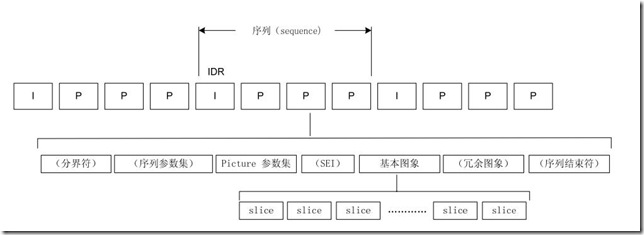文/落影loyinglin(简书作者)
原文链接:http://www.jianshu.com/p/37784e363b8a
著作权归作者所有,转载请联系作者获得授权,并标注“简书作者”。
===========================================
使用VideoToolbox硬编码H.264
前言
H.264是目前很流行的编码层视频压缩格式,目前项目中的协议层有rtmp与http,但是视频的编码层都是使用的H.264。
在熟悉H.264的过程中,为更好的了解H.264,尝试用VideoToolbox硬编码与硬解码H.264的原始码流。
介绍
1、H.264
H.264由视讯编码层(Video Coding Layer,VCL)与网络提取层(Network Abstraction Layer,NAL)组成。
H.264包含一个内建的NAL网络协议适应层,藉由NAL来提供网络的状态,让VCL有更好的编译码弹性与纠错能力。
H.264的介绍看这里
H.264的码流结构
重点对象:
- 序列参数集SPS:作用于一系列连续的编码图像;
- 图像参数集PPS:作用于编码视频序列中一个或多个独立的图像;

2、VideoToolbox
VideoToolbox是iOS8以后开放的硬编码与硬解码的API,一组用C语言写的函数。使用流程如下:
- 1、
-initVideoToolBox中调用VTCompressionSessionCreate创建编码session,然后调用VTSessionSetProperty设置参数,最后调用VTCompressionSessionPrepareToEncodeFrames开始编码; - 2、开始视频录制,获取到摄像头的视频帧,传入
-encode:,调用VTCompressionSessionEncodeFrame传入需要编码的视频帧,如果返回失败,调用VTCompressionSessionInvalidate销毁session,然后释放session; - 3、每一帧视频编码完成后会调用预先设置的编码函数
didCompressH264,如果是关键帧需要用CMSampleBufferGetFormatDescription获取CMFormatDescriptionRef,然后用
CMVideoFormatDescriptionGetH264ParameterSetAtIndex取得PPS和SPS;
最后把每一帧的所有NALU数据前四个字节变成0x00 00 00 01之后再写入文件; - 4、调用VTCompressionSessionCompleteFrames完成编码,然后销毁session:VTCompressionSessionInvalidate,释放session。
效果展示
下图是解码出来的图像

贴贴代码
- 创建session
-
int width = 480, height = 640; OSStatus status = VTCompressionSessionCreate(NULL, width, height, kCMVideoCodecType_H264, NULL, NULL, NULL, didCompressH264, (__bridge void *)(self), &EncodingSession);
-
设置session属性
-
// 设置实时编码输出(避免延迟) VTSessionSetProperty(EncodingSession, kVTCompressionPropertyKey_RealTime, kCFBooleanTrue); VTSessionSetProperty(EncodingSession, kVTCompressionPropertyKey_ProfileLevel, kVTProfileLevel_H264_Baseline_AutoLevel); // 设置关键帧(GOPsize)间隔 int frameInterval = 10; CFNumberRef frameIntervalRef = CFNumberCreate(kCFAllocatorDefault, kCFNumberIntType, &frameInterval); VTSessionSetProperty(EncodingSession, kVTCompressionPropertyKey_MaxKeyFrameInterval, frameIntervalRef); // 设置期望帧率 int fps = 10; CFNumberRef fpsRef = CFNumberCreate(kCFAllocatorDefault, kCFNumberIntType, &fps); VTSessionSetProperty(EncodingSession, kVTCompressionPropertyKey_ExpectedFrameRate, fpsRef); //设置码率,上限,单位是bps int bitRate = width * height * 3 * 4 * 8; CFNumberRef bitRateRef = CFNumberCreate(kCFAllocatorDefault, kCFNumberSInt32Type, &bitRate); VTSessionSetProperty(EncodingSession, kVTCompressionPropertyKey_AverageBitRate, bitRateRef); //设置码率,均值,单位是byte int bitRateLimit = width * height * 3 * 4; CFNumberRef bitRateLimitRef = CFNumberCreate(kCFAllocatorDefault, kCFNumberSInt32Type, &bitRateLimit); VTSessionSetProperty(EncodingSession, kVTCompressionPropertyKey_DataRateLimits, bitRateLimitRef);
-
传入编码帧
-
CVImageBufferRef imageBuffer = (CVImageBufferRef)CMSampleBufferGetImageBuffer(sampleBuffer); // 帧时间,如果不设置会导致时间轴过长。 CMTime presentationTimeStamp = CMTimeMake(frameID++, 1000); VTEncodeInfoFlags flags; OSStatus statusCode = VTCompressionSessionEncodeFrame(EncodingSession, imageBuffer, presentationTimeStamp, kCMTimeInvalid, NULL, NULL, &flags);
-
关键帧获取SPS和PPS
-
bool keyframe = !CFDictionaryContainsKey( (CFArrayGetValueAtIndex(CMSampleBufferGetSampleAttachmentsArray(sampleBuffer, true), 0)), kCMSampleAttachmentKey_NotSync); // 判断当前帧是否为关键帧 // 获取sps & pps数据 if (keyframe) { CMFormatDescriptionRef format = CMSampleBufferGetFormatDescription(sampleBuffer); size_t sparameterSetSize, sparameterSetCount; const uint8_t *sparameterSet; OSStatus statusCode = CMVideoFormatDescriptionGetH264ParameterSetAtIndex(format, 0, &sparameterSet, &sparameterSetSize, &sparameterSetCount, 0 ); if (statusCode == noErr) { // Found sps and now check for pps size_t pparameterSetSize, pparameterSetCount; const uint8_t *pparameterSet; OSStatus statusCode = CMVideoFormatDescriptionGetH264ParameterSetAtIndex(format, 1, &pparameterSet, &pparameterSetSize, &pparameterSetCount, 0 ); if (statusCode == noErr) { // Found pps NSData *sps = [NSData dataWithBytes:sparameterSet length:sparameterSetSize]; NSData *pps = [NSData dataWithBytes:pparameterSet length:pparameterSetSize]; if (encoder) { [encoder gotSpsPps:sps pps:pps]; } } } }
-
写入数据
-
CMBlockBufferRef dataBuffer = CMSampleBufferGetDataBuffer(sampleBuffer); size_t length, totalLength; char *dataPointer; OSStatus statusCodeRet = CMBlockBufferGetDataPointer(dataBuffer, 0, &length, &totalLength, &dataPointer); if (statusCodeRet == noErr) { size_t bufferOffset = 0; static const int AVCCHeaderLength = 4; // 返回的nalu数据前四个字节不是0001的startcode,而是大端模式的帧长度length // 循环获取nalu数据 while (bufferOffset < totalLength - AVCCHeaderLength) { uint32_t NALUnitLength = 0; // Read the NAL unit length memcpy(&NALUnitLength, dataPointer + bufferOffset, AVCCHeaderLength); // 从大端转系统端 NALUnitLength = CFSwapInt32BigToHost(NALUnitLength); NSData* data = [[NSData alloc] initWithBytes:(dataPointer + bufferOffset + AVCCHeaderLength) length:NALUnitLength]; [encoder gotEncodedData:data isKeyFrame:keyframe]; // Move to the next NAL unit in the block buffer bufferOffset += AVCCHeaderLength + NALUnitLength; } }
总结
在网上找到的多个VideoToolboxDemo代码大都类似,更重要是自己尝试实现。
学习硬编码与硬解码,目的是对H264码流更清晰的了解,实则我们开发过程中并不会触碰到H264的真正编码与解码过程,故而难度远没有想象中那么大。
这里有代码地址